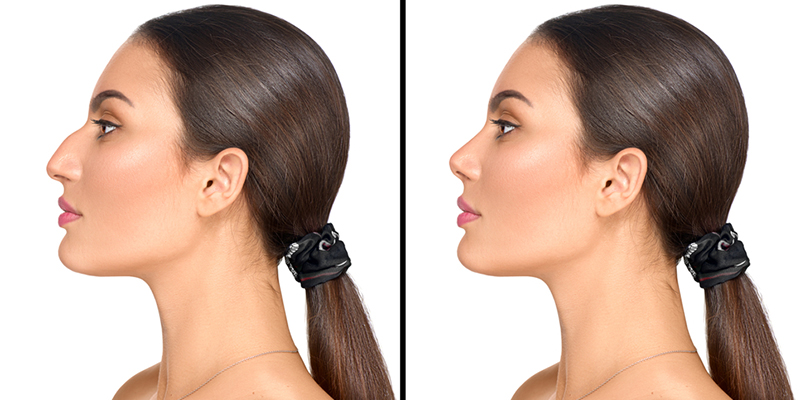Nose surgery, often referred to as Rhinoplasty in medical terms, is performed to fix the shape, size, and appearance of the nasal. While it sounds that rhinoplasty is part of cosmetic surgery, its functional implementation is beyond appearance. The surgery is not just performed at an external level but helps to overcome health concerns that might impact breathing.
Does nose surgery improve breathing? A study by Hospital da Arrábida in Portugal finds that yes, rhinoplasty (Nasal Surgery) does improve breathing. A good breathing helps in respiratory problems such as cold and flu. Furthermore, a composed and free breathing helps in good sleep as well.
This article shares what are some common breathing problems and how a nasal surgery can help you fix the unregulated airflow in your respiratory system.
Anatomy of Nasal Structure:
Human nose is a complex organ which plays a vital role for a smooth flow of oxygen in the respiratory system. To understand how exactly rhinoplasty helps in breathing, comprehending these sub-organs in the nasal is paramount.
- Nasal Passages:
Also known as nasal cavities, these are the two channels extending from the nostrils to the back of the throat. The primary function of these passages is to filter, humidify, and warm the air a person breathes before it reaches the lungs. Cilia – a mucous membrane lining containing tiny hair-like structures, helps to trap dust particles to prevent them from entering the respiratory system.
- Septum:
It is a partition that separates the both sides of the nasal cavity. Septum also provides structural support to the nose as it is composed of cartilage and bone. Furthermore a deviated septum can disturb the airflow and cause breathing difficulty.
- Turbinates:
These are bony structures also known as ‘conchae’ that are responsible for maintaining optimal humidity and temperature in the nasal passages. It comes in three different pairs that are inferior, middle, and superior turbinates. These have the ability to shrink or swell in response to nasal congestion and other factors.
While these are inevitable to sustain a good breathing, there are other components of the nasal. Some of them are sinuses, nasal cavities, lateral walls etc. All these elements have their own role to create and maintain clear air dynamics.
Common Nasal Issues Causing Breathing Problems:
Breathing is a fundamental aspect of our respiratory system that directly influences your overall well being. However, many of the breathing and other functional issues can form if there is any structural damage or deviation happens.
Here’re some most common problems that might require rhinoplasty to correct nasal structure:
Nasal Congestion: This occurs when the nasal passages become blocked or narrowed, making it difficult to breathe through the nose. Causes include colds, allergies, sinus infections, or structural issues such as a deviated septum.
Deviated Septum: The septum is the cartilage and bone that divides the nasal cavity into two nostrils. A deviated septum occurs when it is displaced to one side, causing airflow obstruction and difficulty breathing.
Nasal Polyps: These are noncancerous growths that can develop in the nasal passages or sinuses, causing congestion and breathing difficulties.
Turbinate Hypertrophy: The turbinates are structures inside the nose that help humidify and filter the air we breathe. When they become enlarged (turbinate hypertrophy), they can obstruct airflow and lead to breathing problems.
Rhinitis Medicamentosa: Overuse of nasal decongestant sprays can result in rebound congestion, where the nasal passages become more congested when the medication is stopped, leading to breathing difficulties.
Chronic Rhinosinusitis: Persistent inflammation of the nasal passages and sinuses can result in long-term breathing problems.
All these breathing problems because of poor nasal anatomy or external factors can be treated in a top rhinoplasty surgery clinic by a qualified nasal surgery doctor.
Types of Rhinoplasty for Breathing Improvement:
There are two types of rhinoplasty with distinct purposes. Functional rhinoplasty and cosmetic rhinoplasty serve distinct purposes within the realm of nasal surgery.
Functional Rhinoplasty:
Functional rhinoplasty primarily focuses on improving nasal function and addressing breathing difficulties without significant alterations to external appearance. It aims to correct structural issues such as a deviated septum, turbinate hypertrophy, nasal valve collapse, and chronic sinusitis. Additionally, functional endoscopic sinus surgery (FESS) may be used to treat chronic sinusitis.
Cosmetic Rhinoplasty:
Cosmetic rhinoplasty is geared toward enhancing the external appearance of the nose. It involves reshaping nasal structures to achieve a more aesthetically pleasing and balanced look, addressing concerns like nasal size, shape, dorsal hump, and tip projection. Aesthetic considerations can also be incorporated into functional rhinoplasty, combining improvements in nasal function with subtle enhancements to external appearance, ensuring a comprehensive approach to patient care.
Safety Precautions:
- Choose a board-certified specialist in functional rhinoplasty.
- Discuss openly about concerns, expectations, and medical history.
- Use minimally invasive methods and endoscopic techniques
- Strictly adhere to infection prevention.
- Schedule follow-up appointments for monitoring progress.
Conclusion:
In summary, nose surgery plays a pivotal role in improving respiratory function other than cosmetic enhancements. Studies shows that patients seeking functional rhinoplasty often get concerned about aesthetics after the surgery. So, it becomes important to consult the best rhinoplasty surgeon clearly before getting the rhinoplasty. By addressing conditions like nasal congestion, deviated septum, nasal polyps, and turbinate hypertrophy breathing problems can be solved. Importantly, safety precautions, including choosing a qualified surgeon, open communication, minimally invasive techniques, and infection prevention, are emphasized to ensure a successful and safe rhinoplasty experience.

